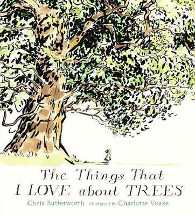The things that I love about trees by Chris Butterworth

Ill. by Charlotte Voake. Walker Books, 2018. ISBN 9780763695699
(Age: 4+) Highly recommended. Themes: Trees, Environment, Seasons.
With the sparest of words, Butterworth encapsulates the reality of a
tree as it has leaves in spring, blossoms and forms fruit in the
summer, which is ready to pick in the autumn and then becoming bare
in the winter. Each season is described in spare prose, making it at
once easy for younger readers to understand and impelling older
readers to find out more. The illustrations bear testament to the
tree and its life cycle through the four seasons, reaffirming the
words as they travel with the tree over its year.
Each page has a new adventure with the tree that is loved. The first
double page shows a young girl coming out of her front door of the
flats to see the bare branches of the plum tree hovering over the
balcony. The tree is covered in tiny sprouting leaves with buds
forming and getting bigger.
We see the buzzing bees as the tree wakes. It is spring.
Later in summer, trees are dressed in their finery, covered with
bright green new leaves. The plum tree has small round fruit
appearing.
As autumn approaches the trees develop coloured leaves as they begin
to shed, and the nuts and fruit ripen for the animals to find and
eat or store.
Winter sees the wind has blown the leaves form the trees, leaving
them bare and stark in the cold. The last double page shows the girl
outside her flat looking at the tree as it waits for spring to come
around once again.
Children will love reading of the trees and their cycle of life, the
contribution they make to their surroundings, and the animals that
benefit from their being there. On each page is the story of the
tree and its life cycle, but also on each page in a different font
are sentences giving facts about the trees. Children will readily
absorb the details as they read the book and its illustrations, a
distinctive style which perfectly suits the words with its lightness
of touch, spare colour and use of white space. I love the branches
arching over the pages, and the floating leaves scattered across
many of the pages, and the perfect stillness of the bare trees in
winter, their magnificence barely needing to be mentioned will make
the reader gasp as they turn the last pages.
At the end of the book is a brief index, allowing children to learn
how to use an index and giving them a reason to go back and look
again at what they have read.
Children will be encouraged to take longer looks a the trees around
them, noting their changes through the seasons, seeing what animals
depend upon the tree and its produce, seeing what they can do with
the tree. Next to the index is a range of things children and
classes can do: collect leaves and nuts, make outlines, collect
leaves, make a shelter etc. I am sure readers and teachers will be
able to think up a pile of other things that children can do when
they finish reading this stunning book, encouraging children to look
anew at what is found outdoors.
Fran Knight